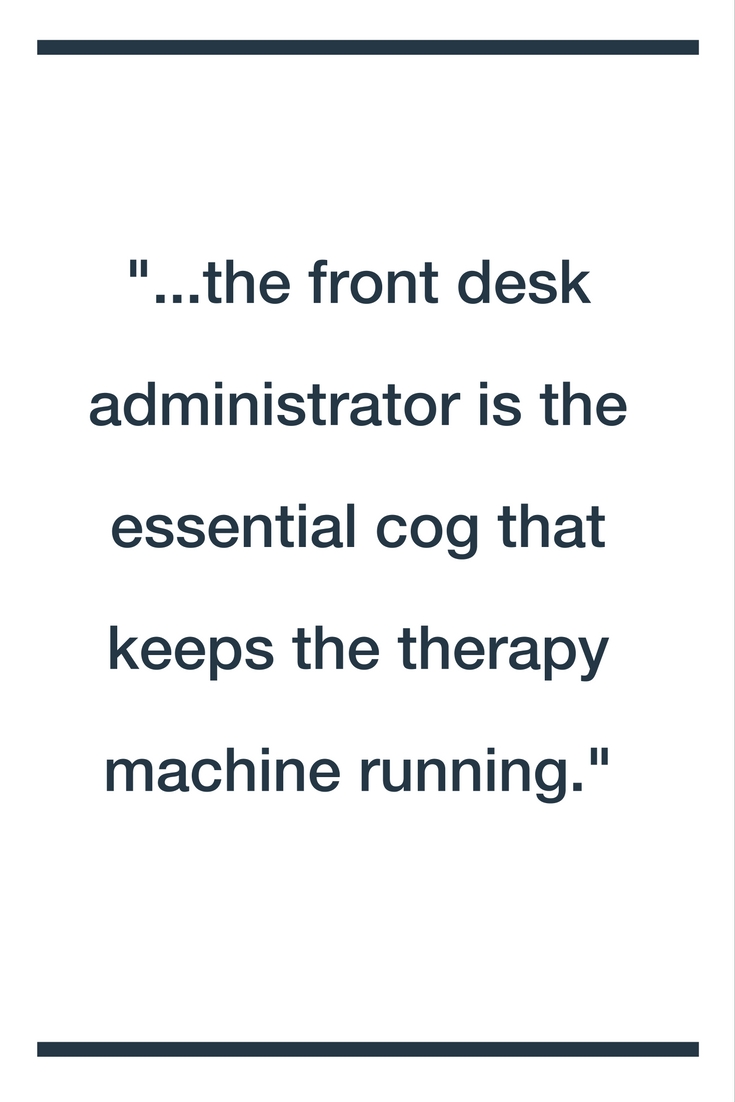A crucial part of any successful outpatient rehabilitation practice is the key work accomplished by an efficient and informed front desk administrator.
From scheduling tasks, to helping patients track their goals, and keeping therapists organized and paid in a timely manner, the front desk administrator is the essential cog that keeps the therapy machine running.
Recently we spoke with Tonya Hunt, front office administrator at Quest Physical Therapy in Issaquah, Washington. In the following interview, Tonya shared tips and advice for ensuring the best possible patient experience while utilizing tools from her Clinicient Total INSIGHT solution.
Q1: The front desk is critical in getting new patient referrals on the schedule. How do you determine if you are successfully converting new patients that call in? Does anything in the Clinicient system tell you how you are doing in converting referrals?
A: We receive most of our referrals through patient call-ins, so our staff wants to make sure that we immediately track and record each of these encounters. If a patient leaves a voicemail then we have to make sure we follow-up with them and get their information in the system. One way we do so is by having a “cancellation list,” which allows us to have new patients on the schedule even if we can’t fit them in right away.
In particular, we utilize a reminder system to keep everyone accountable. Our Clinicient system has a text/email alert that has been really useful and truly shines when applied to new patients who might not have their routine down yet. If they forgot the appointment or can’t make their session, it is really useful for alerting them that they should contact us to reschedule. One logistical tactic we’ve had success with is using the end of each phone call to recap the conversation. It’s often very necessary to confirm the date and time and reiterate important details.
 Q2: Empowered front desk administrators help keep patients on track to meet their treatment goals. How do you manage and monitor a patient’s scheduling frequency? Does anything in the Clinicient system tell you how you are doing in keeping patients scheduled with appropriate frequency?
Q2: Empowered front desk administrators help keep patients on track to meet their treatment goals. How do you manage and monitor a patient’s scheduling frequency? Does anything in the Clinicient system tell you how you are doing in keeping patients scheduled with appropriate frequency?
A: The best way we’ve been able to keep patients accountable is by instituting a 24-hour cancellation policy, which has been a major incentive for them to stay true to the scheduled appointment. No-shows or cancelling last minute are detrimental to practice success, so we try to prevent those as much as possible. By doing so we help keep our clinic running efficiently while making sure our patients are scheduled correctly.
Another way we help keep patients on track with their goals is to schedule 4-6 weeks out so that we have a dedicated care plan. This “rigid” schedule helps set up a routine and keeps them coming in consistently for sessions. Our Clinicient system is a great tool for this, as it seamlessly allows physical therapists to communicate patients’ needs and requirements to the front desk. We then use this information to schedule in a way that encourages the continuation of care. If we need to see where patients have “fallen off of the track” then the report from Clinicient will know who they are and alert us to this.
Q3: A front desk administrator is instrumental in preventing patient cancellations and no shows. How do you prevent cancellations and no shows? Does anything in the Clinicient system help you prevent no shows and cancellations?
As previously mentioned, our $40 cancellation charge is the best tactic we have to prevent cancellations and no shows. Beyond that, we have simple reminders such as printing out all patient appointments even if they are set up for the text alert system.
For our practice management efforts, the Clinicient reports have been helpful as our owner consistently reviews the monthly metrics. He then relays information related to cancellation/no show rates back to us and provides further direction. We use these insights, along with the scheduling system, to have full visibility into our calendar and it allows us to tweak or change certain things. As a result, we’ve been able to achieve a streamlined patient management system that works toward optimal outcomes.
Q4: A front desk administrator is vital in preventing unwanted vacancies in a therapist’s schedule. How do you help keep a therapist’s schedule full? Does anything in the Clinicient system tell you how you are doing in preventing vacancies?
We created therapist-meeting blocks at the top of the schedule as our main tool for preventing unwanted vacancies. Separately, we use the Clinicient system with color coded appointments to track everything, with “red” meaning cancel, “blue” meaning arrivals, and “purple” meaning late. Additionally, we proactively schedule therapists up to one month in advance to make sure they can adjust their time accordingly.
At any time we can pull up any therapist and see their scheduled appointments, cancellation rates, reimbursements and other key factors. This transparency is absolutely crucial for keeping all the wheels moving together. In general, the best part about the Clinicient system is the real-time view it provides into how our practice is performing and operating across all different facets.
There are so many tasks we need to manage as a front office, and being able to quickly see if a patient owes money, needs to schedule a follow-up etc., is a game-changer. I especially like the “quick-glance” screens that allow us to seamlessly switch back and forth between the features.
Overall, I really like that Clinicient enables us to have a full view of the different items we need to track and understand. The system gives us a very hands-on approach thanks to its accuracy and as a result, we’re operating more cohesively as a practice.


Comments